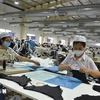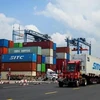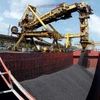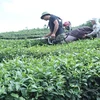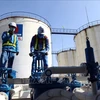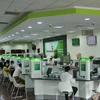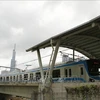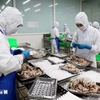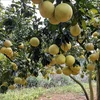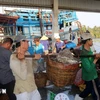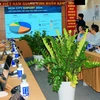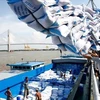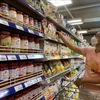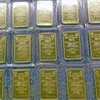In recent years, thanks to fully tapping its sea potential, the island district of Van Don is seeing strong socio-economic development. From a poor island district contributing just 5 billion VND to the state budget in 2005, Van Don has become a large centre of economic development, channeling 45 billion VND in 2011 and 21 billion VND in the first four months of this year.
Perhaps, everyone understands that the sea is Van Don’s greatest asset. With a sea surface area of almost 160,000 hectares and close to large fishing grounds, Van Don treasures rich and various natural marine resources. In particular, the area is blessed with seafood of high economic value such as lobster, abalone, pomfret, mackerel and so on.
In addition to rich aquatic resources, Van Don has a pool of experienced human resources available to reap the benefits from the ocean. For these reasons, Van Don always considered fishing as the economic spearhead of the district. Currently, it has nearly 1,700 fishing vessels, including 100 able to operate offshore.
In 2011, the district’s total output of seafood products reached nearly 19,000 tonnes, including approximately 13,000 tonnes from fishing. In the first four months of this year, the fishing production was only 4,000 tonnes due to a poor jelly-fish crop.
Not only depending on valuable fishing resources, Van Don has also developed resources from its other elements provided by the ocean, namely the use of sea surface area, the tidal flats and also turning poor agricultural land into areas for productive aquaculture.
Presently, further investment has seen the development and expansion of aquaculture, particularly in mollusk farming in Ban Sen, Ngoc Vung, Quan Lan, Minh Chau and Ha Long communes. The district’s total aquaculture area has to date reached 3,100ha, mainly for raising various oysters and shellfish, helping to generate jobs and increase income for local people. Cultivation of pearl-oysters is popular in the district. In the past, culture of pearls started in the summer and ended in autumn. Now, the work takes place throughout the year.
There are three pearl oyster farming enterprises in Van Don with two of them being wholly invested by Japan . The companies employ more than 600 local people and have increased investment in order raise the quality of their products. With the average number of 600 million material oysters raised a year, the companies have harvested, on average, more than 1 tonne of cultured pearls a year.
Besides the benefits from its seafood industry, tourism is also a thriving economic sector in the island district. Van Don is blessed with natural beauty, creating favourable conditions for tourism development. In addition to the Bai Tu Long National Park, Van Don boasts some beautiful beaches stretching several kilometers long, including Bai Dai, Quan Lan, Son Hao, Minh Chau, Ngoc Vung beaches... In addition, Van Don is also home to valuable archaeological treasures and cultural sites, which are described as great potential for tourism development on the island.
In recent years, the district has encouraged and called on investment for developing resorts and tourist products. As a result, tourist infrastructure has been improved significantly, and a number of tourism projects have been put into operation.
The number of accommodation establishments in the district has been increased to 96 units with 1,210 rooms at present from 51 units with 641 rooms in 2008. Every year, tourist numbers to Van Don continue to rise. The island district welcomed 260,000 visitors in 2008, and 440,000 in 2011. In the first five months of this year alone, Van Don provided accommodation services for over 220,000 holiday makers with the peak of 20,000 tourists during the April 30-May 1 holidays.
Van Don is now encouraging all economic sectors to invest in sustainable eco-tourism and the protection of natural resources, whilst shifting rural economic structure towards serving tourism.
Under the Prime Minister’s decision approving the general plan on development of the Van Don Economic Zone until 2020 and vision to 2030, Van Don will become a high-quality centre for ocean and island tourism and entertainment, serving northern Viet Nam and China ’s Hainan island and eastern cities. It will also serve as a venue for international trade, the main driving force for the development of the northern key economic region.
In developing all of it’s economic sectors, Van Don island district is moving quickly towards becoming a dynamic economic zone.-VNA
Perhaps, everyone understands that the sea is Van Don’s greatest asset. With a sea surface area of almost 160,000 hectares and close to large fishing grounds, Van Don treasures rich and various natural marine resources. In particular, the area is blessed with seafood of high economic value such as lobster, abalone, pomfret, mackerel and so on.
In addition to rich aquatic resources, Van Don has a pool of experienced human resources available to reap the benefits from the ocean. For these reasons, Van Don always considered fishing as the economic spearhead of the district. Currently, it has nearly 1,700 fishing vessels, including 100 able to operate offshore.
In 2011, the district’s total output of seafood products reached nearly 19,000 tonnes, including approximately 13,000 tonnes from fishing. In the first four months of this year, the fishing production was only 4,000 tonnes due to a poor jelly-fish crop.
Not only depending on valuable fishing resources, Van Don has also developed resources from its other elements provided by the ocean, namely the use of sea surface area, the tidal flats and also turning poor agricultural land into areas for productive aquaculture.
Presently, further investment has seen the development and expansion of aquaculture, particularly in mollusk farming in Ban Sen, Ngoc Vung, Quan Lan, Minh Chau and Ha Long communes. The district’s total aquaculture area has to date reached 3,100ha, mainly for raising various oysters and shellfish, helping to generate jobs and increase income for local people. Cultivation of pearl-oysters is popular in the district. In the past, culture of pearls started in the summer and ended in autumn. Now, the work takes place throughout the year.
There are three pearl oyster farming enterprises in Van Don with two of them being wholly invested by Japan . The companies employ more than 600 local people and have increased investment in order raise the quality of their products. With the average number of 600 million material oysters raised a year, the companies have harvested, on average, more than 1 tonne of cultured pearls a year.
Besides the benefits from its seafood industry, tourism is also a thriving economic sector in the island district. Van Don is blessed with natural beauty, creating favourable conditions for tourism development. In addition to the Bai Tu Long National Park, Van Don boasts some beautiful beaches stretching several kilometers long, including Bai Dai, Quan Lan, Son Hao, Minh Chau, Ngoc Vung beaches... In addition, Van Don is also home to valuable archaeological treasures and cultural sites, which are described as great potential for tourism development on the island.
In recent years, the district has encouraged and called on investment for developing resorts and tourist products. As a result, tourist infrastructure has been improved significantly, and a number of tourism projects have been put into operation.
The number of accommodation establishments in the district has been increased to 96 units with 1,210 rooms at present from 51 units with 641 rooms in 2008. Every year, tourist numbers to Van Don continue to rise. The island district welcomed 260,000 visitors in 2008, and 440,000 in 2011. In the first five months of this year alone, Van Don provided accommodation services for over 220,000 holiday makers with the peak of 20,000 tourists during the April 30-May 1 holidays.
Van Don is now encouraging all economic sectors to invest in sustainable eco-tourism and the protection of natural resources, whilst shifting rural economic structure towards serving tourism.
Under the Prime Minister’s decision approving the general plan on development of the Van Don Economic Zone until 2020 and vision to 2030, Van Don will become a high-quality centre for ocean and island tourism and entertainment, serving northern Viet Nam and China ’s Hainan island and eastern cities. It will also serve as a venue for international trade, the main driving force for the development of the northern key economic region.
In developing all of it’s economic sectors, Van Don island district is moving quickly towards becoming a dynamic economic zone.-VNA
